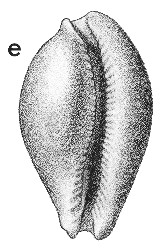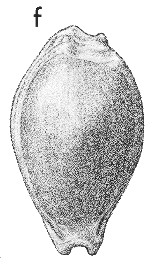
Revised descriptions of New Zealand Cenozoic Mollusca from Beu and Maxwell (1990)

 | Revised descriptions of New Zealand Cenozoic Mollusca from Beu and Maxwell (1990) | 
|
  (Pl. 24e): GS10344, D45/f8483, Calamity Point, Clifden, Altonian (GNS) |
  (Pl. 24f): GS10344, D45/f8483, Calamity Point, Clifden, Altonian (GNS) |
Beu & Maxwell (1990): Chapter 11; p. 222; pl. 24 e,f.
Synonymy: Notoluponia (Notadusta) clifdenensis Cernohorsky 1971a, p. 123
Classification: Cypraeidae
Description: Size moderate for family (height 30-55 mm), elongate-ovate. Spire covered by callus, barely distinguishable on most shells except by a shallow groove around its base. No sculpture. Aperture narrow, not strongly curved, inner and outer lips almost parallel, denticulate over virtually entire length; inner lip flattened anteriorly, outer edge sharply margined, with a prominent oblique ridge at base and 18-20 denticles above. Outer lip margined anteriorly and posteriorly, bearing 24-29 denticles within.
Comparison: Cypraea clifdenensis is by far the most widespread and therefore best-known New Zealand fossil cypraeid, and is not uncommon in the Long Beach Shellbed at Clifden. C. (Notadusta) trelissickensis (Duntroonian, Castle Hill Basin) is much smaller (height about 18 mm), has a more strongly curved aperture, and has a non-projecting spire. (The shell from Pakaurangi Point so identified by Cernohorsky (1971a, fig. 16) is probably not conspecific). Only three other species of cypraeids have been described from New Zealand; two of these, Cypraea ficoides (?Whaingaroan, "Oamaru" — possibly from Hutchinson's Quarry) and Bernaya zoiloides (Bortonian, Pahi, Northland) were based on very poorly preserved internal moulds and should never have been named. In particular, the type of C. ficoides is an incomplete steinkern partly imbedded in very hard limestone and is quite indeterminate, although this has not deterred some workers from applying the name to a variety of fossil cypraeids (e.g. the large steinkern from Parengarenga Harbour (Altonian) figured by Cernohorsky 1971a, fig. 15).
Cypraeids have a sporadic record from earliest Eocene (see Palaeocypraea eripnides, Pl. 4j,k) to Recent in New Zealand. Their general rarity and low diversity suggest that New Zealand was never fully tropical.
Distribution: Otaian-Kapitean; Long Beach Shellbed, Clifden, Altonian (type); Fouraye Siltstone, Calamity Point Sandstone and Slip Point Siltstone, Clifden; Pakaurangi Formation, Pakaurangi Point, Kaipara Harbour; Paratoetoe, Parengarenga Harbour; Ngakonui Stream, Pahaoa River, Wairarapa, Waiauan; Maruhou Point, Te Araroa, East Cape, Kapitean (1 specimen).
Cite this publication as: "A.G. Beu and J.I. Raine (2009). Revised
descriptions of New Zealand Cenozoic Mollusca from Beu and Maxwell (1990). GNS
Science miscellaneous series no. 27."
© GNS Science, 2009
ISBN
978-0-478-19705-1
ISSN 1177-2441
(Included with a PDF facsimile file
copy of New Zealand Geological Survey Paleontological Bulletin 58 in CD version
from: Publications Officer, GNS Science, P.O. Box 30368 Lower Hutt, New
Zealand)